In November 2017, I reviewed the Kowa SET-R, a 35mm leaf shutter SLR made by Kowa Optical Works of Japan between the years of 1968 and 1970. That camera was my third Kowa SLR, the first two being DOA when I received them.
As they say “third time’s a charm”, my third Kowa SLR not only worked great, but my experience with the resulting images that I got from it were so spectacular, it was almost as if there was something magical about it’s use that made nearly every image I shot look great.
 At the time of that review, I only had the 50mm f/1.9 Kowa lens and in the months that would pass, I wondered what some of the other lenses for the camera might be like. While normally I tend to favor wide angle lenses on SLRs, in the fall of 2019, I stumbled upon a 135mm lens for the camera and thought I should give it a chance.
At the time of that review, I only had the 50mm f/1.9 Kowa lens and in the months that would pass, I wondered what some of the other lenses for the camera might be like. While normally I tend to favor wide angle lenses on SLRs, in the fall of 2019, I stumbled upon a 135mm lens for the camera and thought I should give it a chance.
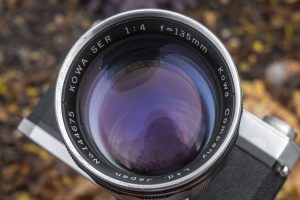
As soon as I mounted the lens to the Kowa, I couldn’t help but marvel at it’s beauty. If you like large front glass elements, this is the lens for you. It has a 67mm filter ring and the front element takes up nearly that entire space with only a narrow vanity ring around it. The lens coating is still in pristine condition with a beautiful purple/bluish hue to it. I don’t know exactly what kind of coating this is, but it doesn’t show any sort of yellowing that was typical of many 50s and 60s lenses.
As you might guess with such large glass elements, the Kowa 135mm has some heft. Weighing in at 562 grams by itself, when mounted to the Kowa SET-R, the combined weight of 1218 grams makes for a rather hefty carry.
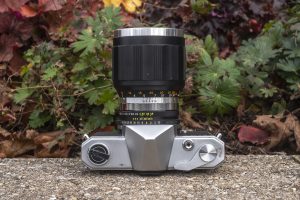
Shooting with the lens is a joy. Although quite a bit larger than the standard 50mm lens I previously shot on this camera, it’s size was still manageable, and with the extremely wide focus grip, was very easy to use. At a total length of 88mm, the focus ring takes up more than half of it’s total length.
The minimum focus distance is 1.7 meters or just under 6 feet, which is quite good for a telephoto lens on a leaf shutter SLR. Leaf shutter SLRs like the Kodak Retina Reflex or Voigtländer Bessamatic series often struggle with minimum focus distances because of the smaller opening of a leaf shutter compared to a focal plane shutter SLR which causes them to have very long minimum focuses.
For comparison, both the Schneider-Kreuznach Tele-Xenar 135mm f/4 lens for the Retina Reflex and the Voigtländer Super-Dynarex 135mm f/4 for the Bessamatic each have a minimum focus distance of 13-14 feet. It gets worse with longer lenses like the Retina-Tele-Xenar 200mm f/4.8 at 22 feet, and the Voigtländer Super-Dynarex 350mm f/5.6 at a whopping 90 feet!
The lens has 5-elements in 4 groups which is a step up from the usual 3 and 4 element design of medium telephoto lenses, which suggests it should be capable of superior sharpness, especially in the corners.
I told myself when I started writing this lens review, that I didn’t want to get too technical so I didn’t do any more testing. I did not shoot at any lens charts or look for things like barrel distortion or optical anomalies like coma. I just put it on my camera, loaded in some film, and took it out.
Below is a gallery I shot with this lens on the SET-R at Brookfield Zoo in the fall of 2019. The film was fresh Kodak TMax 100 and I developed it myself using HC-110b.
Not having much experience with too many telephoto lenses as I normally shoot 50mm and under, I didn’t have very high of expectations, but I was pleasantly surprised when the first scans started to appear on my computer. For starters, the slower f/4 maximum aperture did not affect my ability to compose through the Kowa’s reflex finder. Considering my only experience with this camera was using the much faster f/1.9 50mm lens, I was worried how it might affect my ability to focus, and I’m pleased to say, not at all.
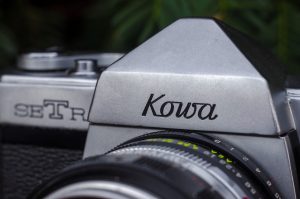
I don’t think I’ve ever heard anyone ever praise Kowa as a top tier lens maker in the vein of Zeiss or Nikon, but the consistently excellent results I got from the 50mm lens extended to the 135mm. I don’t know what kind of lens formula this is, but this 5 element lens performed admirably.
I already heaped a lot of praise on the Kowa SET-R in my original review, but now having shot a second lens on it, I feel as though this could have been a very viable system camera for someone looking for an alternative to other models back in the late 1960s when this camera was sold new.
I doubt there’s too many people out there still shooting Kowa SLRs, but if you ever stumble upon any of the lenses for this camera, especially this 135mm f/4 lens, it might be worthwhile to seek out a body for it, or at the very least, try to adapt it to digital where I feel very confident in saying it should do a very good job!
The Kowa 135mm f/4 lens did an outstanding job on the camera it was intended to be used on, but today in 2021, people often adapt lenses digitally, to see how they perform on the ultra high resolution sensors and digital displays that current technology affords us.
While I don’t have an adapter for the Kowa’s mount to any of my digital cameras, a photographer named Nikolaus Burgard did, and he created a gallery of breathtaking images with this lens on a Sony alpha 7 III and wrote about his experience on this site. I strongly recommend you check out Nikolaus’s work if you want to see what this lens is capable of on digital.
https://www.nikolaus-burgard.de/objektivvorstellungen-lens-reviews/kowa/kowa-ser-135mm-f4/
Related Posts You Might Enjoy

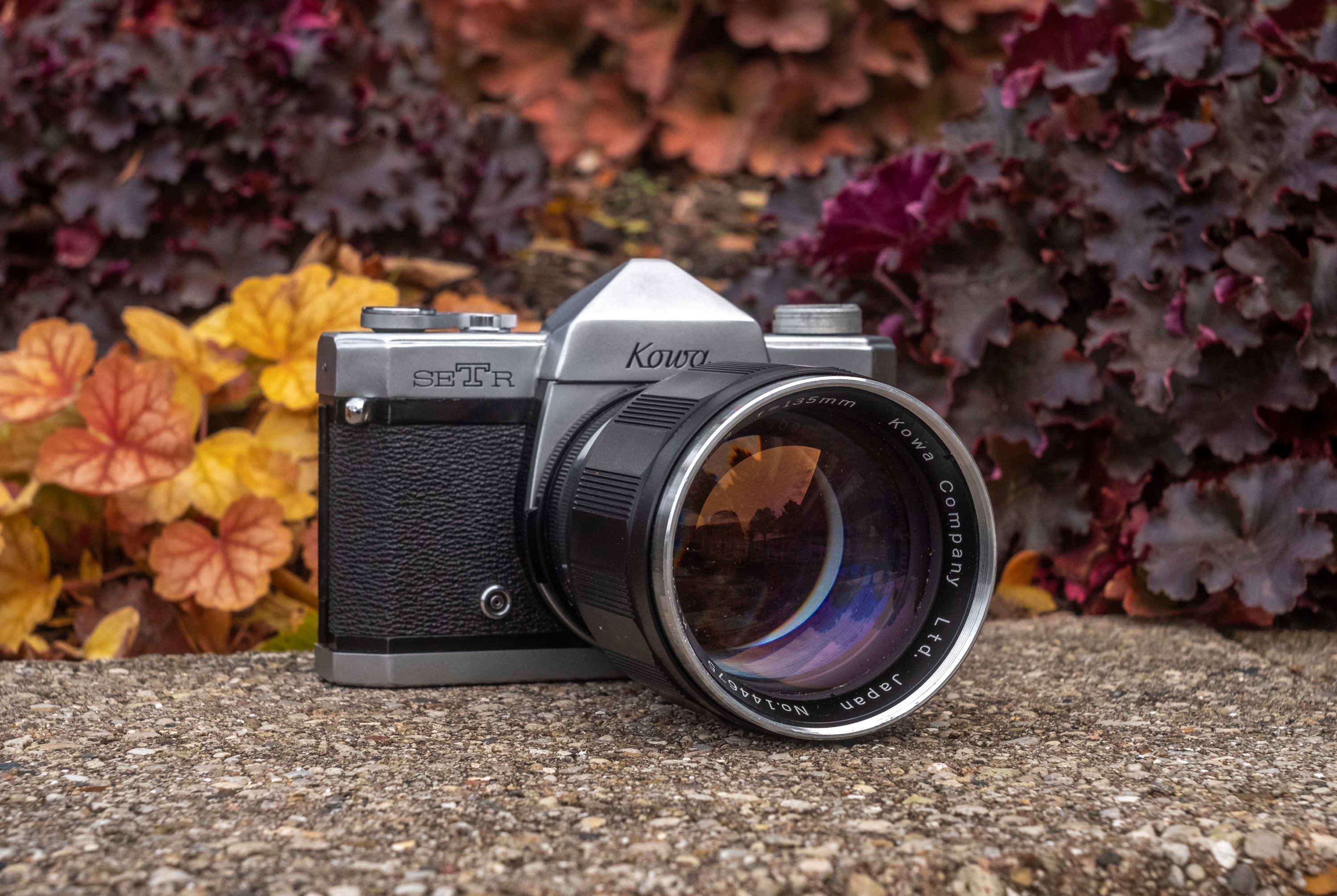
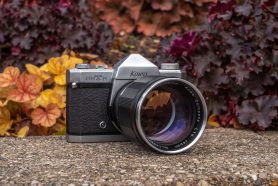












The Kowa SETR series are unquestionably underrated. In terms of reliability, as well as their superior features (such as TTL metering and instant return mirror) and lens offerings, they are head and shoulders above other leaf shutter SLRs such as the Bessamatic, Retina Reflex and Contaflex. Any leaf shutter SLR is a complex machine, but Kowa came the closest to making one that could compete against mainstream focal plane SLRs with no apologies. Nonworking ones have a much better chance of resurrection than their German counterparts, and are much more worth the effort involved.
Well said Richard! I don’t have the experience of working inside of them like you do, but from a user standpoint, this camera very much feels like a leaf shutter SLR both in ergonomics and function. Theres no bizarre location for the aperture wheel on the bottom of the lens mount like the Retina Reflex, or exposure dial on the front of the camera like the Contaflex. The results speak for themselves. Their lenses and bodies were really well made! I want to get more lenses for this system! 🙂
Hi Mike,
You say the 135 is an F/3.5 but it looks like it says F/4? It is probably splitting hairs for the speed difference, but I’d like to throw in my two cents on Kowa glass. I have rangefinder cameras 140 and the Wide models and the lenses, esp the 35/2.8 and the 50/1.4 are stellar in my opinion. Even though I have the 85/F3.5 for the 140, I truly don’t ever remember using it. I think the Prominar optics were Kowa’s shining light.
Yeah, I totally dropped the ball there. The lens is definitely f/4. Another reader pointed it out to me as well, and I’ve since updated the review. Thanks for catching it though!
Vintage 135s are always my soft spot tbh, very few will dissapoint. But I’m curious, on the name plate of the lens it says 135mm 1:4, so wouldn’t this lens be a f/4 rather than f/3.5?
Aaaaah, you’re right! I don’t know how I missed that. I have updated the review to indicate f/4. Nice catch!
Based on what Richard Oleson says about the superior construction / reliability of the Kowa SLRs, it might be interesting to ask Chris Sherlock to share his opinion. Despite trading under the banner of “Retina Rescue”, Chris works on other marques provided they have removable front lens element assemblies and leaf shutters, and may have experience on the SET series. Chris restored a pair of Agfa Karat 36s with f2 Heligons to a condition equal to new. (You can see this restoration step by step on his YouTube channel if you’re interested).
Great camera and great lens. I’m still waiting for the negatives from my inaugural roll, however, so it’s good to see your samples first.
I finally took my Kowa SET-R for a try with some 100 ASA film (purchased in bulk) around one of the older areas that my city. I must say that the quality of the photos were amazing. They did hold up against my Leica and Nikon F cameras. It takes awhile to get used for the shutter. The film advance works without using the shutter to taken a photo. Not a big deal, but it is far easier for load film. I justify hope that it will be last. My first one was DOA but came with a neat vintage strap.